Retailing
Newer 'Retailing' postings can be found here.
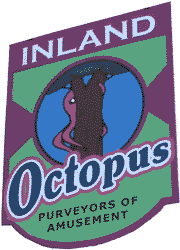 Octopusgate: The Inland Octopus of Walla Walla, WA may be the world's best little toy store. Owner Bob Catsiff is cheerful, helpful and obviously loves his business. We buy lots of things every time we go there. Octopusgate: The Inland Octopus of Walla Walla, WA may be the world's best little toy store. Owner Bob Catsiff is cheerful, helpful and obviously loves his business. We buy lots of things every time we go there.
The place is full of whimsical, neat stuff, including lithographed tin toys which are both enthralling yet sharp enough to slash the throats of screaming, ill-behaved toddlers. Just like toys used to be. (This is why children were polite and circumspect in the 1950s.)
Earlier this year, the store relocated a couple of blocks westward in the downtown core. The new building had a plain white front, which Catsiff, working with local artist Aaron Randall, replaced with a mural. The project had been discussed with Walla Walla officials but after the work was done, the city council decided that the colors were too bright and declared the mural a 'sign' which violates the city sign code.
Most of the populace, including the store's target demographic - children - enjoy the mural. One supporter left his opinion in pink chalk on the sidewalk in front of the store.
A legal fight is now brewing.
I took a photo of the new store front and posted it here. I like the look of the mural. It is distinctive but doesn't overwhelm the neighboring store facades. The many trees along the street act as visual blending elements.
I think Walla Walla needs more creative merchants like Bob Catsiff. Too many retailers offer the same, so-so merchandise in tired, uninspired surroundings.
Inland Octopus is growing because it is clever and novel. If only all stores were so cool. (posted 10/25/2010, permalink)
False Advertising: The latest Crate & Barrel catalog, which arrived last week, offered neither crates nor barrels. (posted 5/28/2010, permalink)
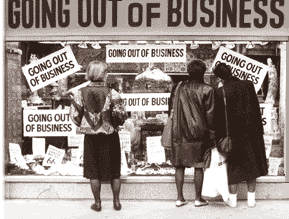 Mall De La Mort: I hadn't visited the Westfield Vancouver Mall in over a year. Mall De La Mort: I hadn't visited the Westfield Vancouver Mall in over a year.
Apparently neither had anyone else. More stores than ever are gone; it seemed like almost half the spaces were vacant.
Even the kiosks were sparse.
The remaining stores appeared to specialize in shoes or impulse items. We were the only customers in Macy's.
All the people we saw in our mall travels were either store employees or geezer mall walkers getting their daily exercise.
I think malls are on the way out.
People buy stuff they need at Costco, Wal-Mart or on the internet. (posted 3/31/2010, permalink)
More Retail Woes: Saks will close its two stores in Portland's Pioneer Place Mall. The company currently operates a 60,000 square-foot store and a 23,000 square-foot men's store. Saks first arrived in Portland in 1990. Last year, Saks reported sales declines of 13.5% to $2.6 billion.
Williams-Sonoma Inc. and Pottery Barn plan to shrink their brick and mortar footprints as well. Pat Connolly, executive vice president has said, "We are committed to restoring our retail channel profitability to historical levels ... We are working diligently to restructure our portfolio of stores and optimize our sales and costs per square foot. This will be accomplished by selective store closings and lease negotiations." He added, "E-commerce is 30 percent of our corporate revenue and it's very profitable ... even in this environment. The Internet and e-commerce have become the focus on our capital investment."
Foot Locker Inc. plans to close about 150 underperforming stores in 2010. Last year, the retailer closed 179 stores.
Last month, Samsonite Corp. filed for Chapter 11 bankruptcy protection and announced plans to close 85 stores.
Naturally, these closings mean more vacant space and less demand for new retail construction. Trade group Associated General Contractors reported that Portland lost 9,100 construction worker jobs in 2009. "The Portland area - which includes Vancouver WA - saw an 18% decline from January 2009 to January 2010." (posted 3/25/2010, permalink)
Mall Desperation: James Lileks has described one shopping mall as seeming crowded "because the main floor was full of temporary kiosks, which gave the place a rather jumbled, desperate feel, like a souk set up in a warehouse to trade things after civilization had collapsed."
Meanwhile, Doug McIntyre has reported, "The e-commerce industry posted its first $900 million day, ever ... on December 15, e-commerce sales hit $913 million. The surge held put holiday online sales up 4% to almost $24.8 million through the week ending December 18. So far this year, the spending on nine days has risen above $800 million.
E-commerce will almost certainly have an outstanding year, which was not expected several weeks ago. Analysts believed that a weak holiday spending season would bring down online sales and store sales as the consumer continued to be unusually frugal due to tight credit and concerns about unemployment.
Data so far show that while e-commerce revenue is rising, sales in physical stores my be down 2% for the holiday. Online sales are still not big enough to make up for that drop." (posted 12/23/2009, permalink)
Used-to-be Retailing: We live in an age of internet shopping, big box stores, supermarkets and items which cannot be repaired, resized or re-soled.
Consider the street scene in 1937 Darby - a Philadelphia suburb. On a single block, you'd find a sample shoe store (samples were short runs of shoes made as display/presentation samples for salesmen to show store buyers - also discontinued low volume runs), an establishment which repairs shoes and cleans and blocks hats, a tailor, dry cleaner and dyer (yes, you could have clothes dyed; shoes, too) a retailer selling stationery and sundries and a store dedicated to selling small appliances (no big refrigerators here - just radios, toasters, curling irons, etc.).
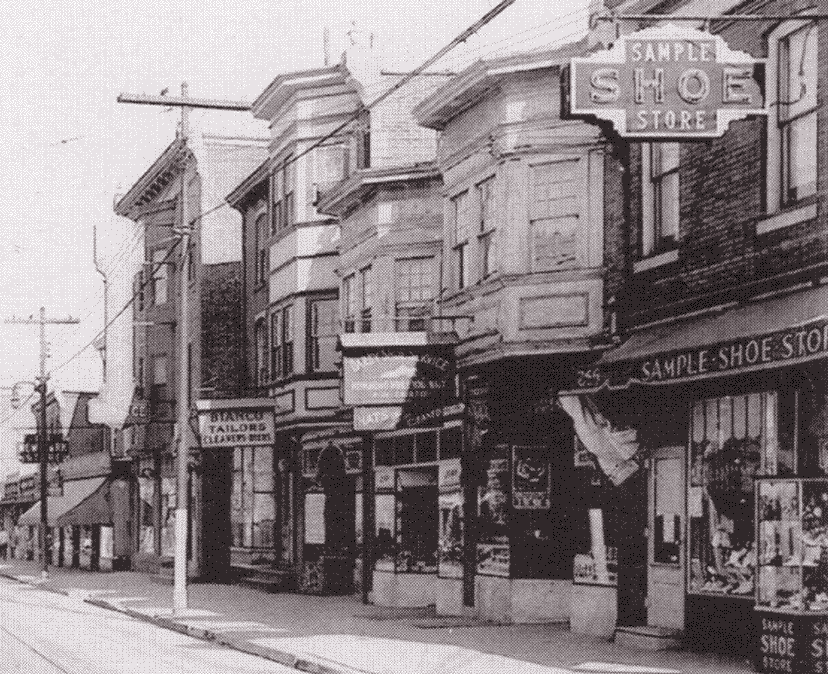
Many of these stores offered extras - the small appliance store probably did repairs in the back of the store. The tailor shop not only performed alterations but could probably custom-make suits or dresses if desired. Stationery stores often had a small printing press in the rear of the store as well as embossing capabilities.
These days, everything is in tamperproof packaging and customization is rarely permitted. 'Take it or leave it' seems to be today's retail motto.
There was a bad recession in 1937. Maybe the recession of 2009 will inspire the return of customer service.
Of hat blocking, I'm not so sure. (posted 10/13/2009, permalink)
We Were There First: Over the years, the Sherlocks have been ahead of many trends. Douglas McIntyre, writing about possible structural changes in the economy, opined, "A population that used to keep cars for two years is now willing to keep them for four. It could be a change in behavior which, over the long term, would be more damaging to the industry than the recession has been. America could become a nation where people do not think their cars are "old" until they have 100,000 miles on them."
We bought our first new car in 1967; when we sold it in '95, the odometer read just over 156,000 miles. Subsequent auto purchases have usually remained in the family for 8-12 years, racking up 80-130,000 miles. Even the fairly awful ones.
I opened my first Individual Retirement Account in 1978. My bank didn't know how to do it and made me come back the next day, pleading for extra time to "make some phone calls and do some studying." We took vacations in neat places - before they were declared "must-see destinations" by travel media.
My wife started laddering our CDs in '79, 15 years before the term became part of the investment lexicon.
In the '80s, when Money magazine was touting mutual funds as the New Big Thing, we were amused. We had begun investing in mutual funds in early 1969.
In '88, when our friends started to send dot-matrixed annual newsletters with Christmas cards, we responded with video newsletters ... waaay before YouTube. We were "cocooning" long before Faith Popcorn coined the term. I also had a home-based business before it was fashionable.
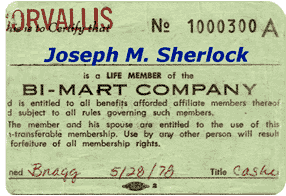 Not realizing that we were setting another trend, we've been shopping at Wal-Mart for over 20 years and Costco for almost 25 years. Before Costco and Wal-Mart came to our area, we shopped at Bi-Mart, an Oregon discount club/chain. I signed up for a Lifetime Membership in May 1978. Not realizing that we were setting another trend, we've been shopping at Wal-Mart for over 20 years and Costco for almost 25 years. Before Costco and Wal-Mart came to our area, we shopped at Bi-Mart, an Oregon discount club/chain. I signed up for a Lifetime Membership in May 1978.
Recently, I read this: "The recession steered a new type of customer to Wal-Mart - deeper in the pockets and suddenly looking for bargains. Now the world's largest retailer has to figure out how to keep that customer when the economy recovers. So Wal-Mart is bringing in more brand names, ditching scores of other products, and redesigning hundreds of stores to give them wider aisles, better lighting, and better sight lines. It's more than just a cosmetic upgrade. That new breed of customer also spends about 40% more than the traditional Wal-Mart shopper and the retailer senses an opportunity to accelerate its growth."
The prototype for the remodeling includes lower shelves to make it easier to see across the store, better lighting and wider aisles. Expanded electronics areas will include interactive displays to test video games and portable gadgets. The store now carries brands like Danskin and Better Homes and Gardens, and its electronics section now stocks pricier products.
"Wal-Mart executives say 17% of the chain's traffic growth in February came from new customers, and they're spending 40 percent more per trip. More than half of those shoppers living in households that take in more than $50,000 a year. While that may not be considered affluent, it's a big departure from Wal-Mart's core customers, of whom one in five does not have a bank account or has limited access to financial services." (posted 7/3/2009, permalink)
Dead Mall Walking: General Growth Properties Inc. has filed the biggest real estate bankruptcy in U.S. history after amassing $27 billion in debt during an acquisition spree that turned it into the second-largest shopping mall owner.
General, which purchased developer Rouse Co. in 2004, owned Boston's Faneuil Hall, Tysons Galleria in the D.C. area, Harborplace & The Gallery in Baltimore's Inner Harbor, The Galleria in Dallas, the Grand Canal Shoppes at The Venetian in Las Vegas and the South Street Seaport in NYC. Rouse and 165 units were included in the bankruptcy filing.
General Growth owns seven malls in Washington state, including Three Rivers in Kelso. The firm also owns Pioneer Place in Portland.
Last week, I walked around Jantzen Beach in Portland. This once-thriving mall is nearly deserted - its big box stores (Circuit City, Linens 'n' Things, Ritz Camera, etc.) are either shuttered or in the midst of going out of business. Inside the mall, there are lots of empty spaces and the people walking around were either befuddled oldsters or scumbags who looked like they're in a long-term relationship with heroin. This Oregon mall is just across the border from Washington and should be full of shoppers attracted by the zero sales tax, compared with Washington's 8%.
Malls seem to be soooo over. And so are many stand-alone retailers as more and more folks buy online, at Costco or at Wal-Mart. (posted 4/20/2009, permalink)
Closing Forever: Gottschalks Inc., a venerable Western department store chain, is being liquidated. Founded in Fresno in 1904, Gottschalks operated 58 department stores and three specialty stores. It had about 5,200 employees in California, Oregon, Washington, Alaska, Idaho and Nevada. (posted 4/3/2009, permalink)
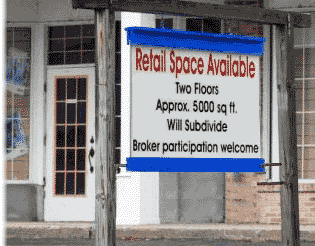 Sun-Dried Doom: Jeremy Clarkson has been in the same kinds of stores as me, it seems. Sun-Dried Doom: Jeremy Clarkson has been in the same kinds of stores as me, it seems.
"According to the men in braces who put our money somewhere and can't quite remember where, up to 15 big high street retailers will disappear from town centres in the coming months. And if my local town is anything to go by, they will undoubtedly be joined by all those little boutiquey delicatessen bijou cubbyhole shops that smell of sun-dried tomatoes and potpourri. The ones run by stick insect blonde women and paid for by their husbands to stop them running off with the gym instructor."
Here in the U.S., Barry Ritholtz noted that "a plethora of commercial retail space is for rent. I have never seen so many empty store fronts and in very nice areas. The FedEx Kinkos by us is toast; A number of local family owned shops are empty with big For Rent signs in the window. The Harvey's Electronics that closed 8 months ago is still for rent.
The Retail sector is downsizing. That means fewer stores, few square footage, few employees and perhaps even fewer chains. The new frugal future is here, and that means tighter margins for retailers, with little room for error.
Even if the economy recovers tomorrow, we still have excess retailers. Mortgage equity withdrawal is a non-option, leverage is coming out of the system and wages are stagnant. The next 10 years in Retail with look nothing like the previous 10 years.
It's obviously already been impacting the REITs, but this is very bad news for the commercial real estate market. What do you do when your industry gets appreciably smaller, other than suffer some pain and consequences?"
I wonder what part of the damage is due to the continued rise of online shopping. I bought most Christmas gifts over the internet last year. And I've noticed a lot of empty storefronts (with For Lease signs plastered on the windows) all over the Portland/Vancouver metro area as well. (posted 1/5/2009, permalink)
Blue Christmas: 24/7 Wall St. has just released a list of retailers "who may not see 2009", noting that "retailers who need access to capital for inventory, rent and personnel costs are finding that it is nearly impossible to get access to funds without a pristine balance sheet and a history of substantial positive cash flow. These troubles point to a number of other retail chains going out of business between now and early next year."
The list includes Dillard's department stores, a regional chain with 318 outlets, Talbots - 878 stores, Pier 1 whose shares now trade at 50¢ or so, Cost Plus - a 296-store retailer, Williams-Sonoma (600 stores - Barclays Capital recently said that it may violate financial covenants on its $300 million credit facility), 400-store Eddie Bauer and Rite Aid, which also owns Eckard Drugs. A Raymond James analyst recently said, "Rite Aid has the worst balance sheet of any company I follow." (posted 12/3/2008, permalink)
The Truth About Costco: I really like Costco - the employees are friendly and the prices are great. I was surprised to learn from an article in Better Investing magazine that, while the company has total revenues of $63.1 billion per year and membership fees account for a mere $1.3 billion of that, those membership fees account for 82% of the firm's operating income.
Thankfully for Costco, member renewal rates are 87%. (posted 11/21/2008, permalink)
The Unbearable Lightness Of Being A Retailer: Westfield Vancouver Mall, Clark County’s largest and first major retail center, was built in 1977. And has been refreshed a few times since. It's now full of empty storefronts and light on foot traffic, due to the nation's change in shopping habits.
Once upon a time, Mall Walking was a leisure activity, especially in the rainy Pacific Northwest. People strolled malls to be dazzled and see what was new and trendy. And make impulse purchases. And buy a Cinnabon or two.
Today, people do their shopping at big box stores. Or on the internet. Last month, Wal-Mart, the world's largest retailer, and Costco posted solid gains in same-store sales - those at stores open at least a year - a key indicator of a retailer's health. Costco was up 10%, exceeding expectations.
In the first quarter of 2008, nationwide store-related retail sales were down by the largest margin in decades. Store closures in Vancouver include the Disney Store, Wilson's Leather (the entire chain is being liquidated), Gordon's Jewelers and Ambiance Unlimited. The company running the Disney Stores filed for bankruptcy.
Other mall-based apparel stores, including Limited Brands and Gap, suffered even deeper declines last month. Sales at Limited, owner of the Victoria's Secret lingerie chain, were down 5 percent nationally, while the Gap reported an 11 percent decline. J.C. Penney declined 6.5 percent.
Sharper Image, Lillian Vernon, Mervyn's, Ames, Harvey Electronics, Good Guys, Levitz, Bombay, Movie Gallery, Tweeter, Wickes Furniture and many other specialty retailers have filed for bankruptcy. Pacific Sunwear will close its 154 remaining Demo stores. Ann Taylor is closing many of its stores. Linens 'n Things is shutting 57 stores nationwide.
Zales and Piercing Pagoda will close over 100 stores by year end. Dillard's Inc. will close another six stores this year. Eddie Bauer has already closed 27 shops in '08 and plans to close up more outlet stores by year's end.
Fellow mall-fixtures, Mrs. Fields (of cookie fame) and TCBY frozen yogurt, just filed Chapter 11 papers.
Over the years, the U.S. retail market has grown almost every year. But when Amazon, Costco and Wal-Mart achieve double digit sales gains, something has to give. And most of the 'give' is coming from the traditional retailer. At first, it was the little mom-n-pops which were closing; now the larger chains find themselves unable to adapt to these new times. (posted 8/20/2008, permalink)
The View From IKEA: Last week, we shopped at the IKEA store in Portland. Had lunch in the cafeteria, too - always a treat - good food and a great value.
I'm a sucker for IKEA's meatball platter - mashed potatoes with meatballs, cream sauce and lingonberry jam, all for under five bucks. But to get to the restaurant, you have to wander through IKEA's meandering Orwellian maze of furniture displays along with all the other lemmings ... ummmm ... shoppers.
The IKEA experience is always interesting ... (more >>>) (posted 7/11/2008)
Mall Walking: Last week, I strolled around the Vancouver Mall and made my first visit to the new Macy's which is very nice. It's a big improvement over the old dumpy Meier & Frank department store, which Macy's took over.
The rest of the mall is in bad shape though, with a lot of boarded up vacant stores, including the big Mervyn's. In the U.S., shopping mall traffic peaked in the late 1980s and has been slipping ever since. Mall traffic was down over 10% percent last year. More than 300 U.S. shopping malls have closed in recent years. No developer has announced plans for an enclosed mall in 2008 or the first quarter of 2009.
In 2008, the number of new store closings will climb to 5,770, according to a recently released ICSC report, 'Retail Real Estate Business Conditions'. Ann Taylor announced that it will close 117 stores between now and 2010; Charming Shoppes plans to close 150 stores. Wilsons Leather is shuttering 160 out of its 260 mall stores as a result of declining sales. The Vancouver Mall Wilsons closed earlier this year.
Why? The internet, for one thing. Take music, for example. About 2,700 record stores have closed across the country since 2003. Apple's iTunes Music Store, which launched in the spring of 2003, is now America's largest music retailer. Consumers have bought more than 100 million iPods in the first 6 years since its intro in 2001. One in every four songs sold in the U.S. is sold through iTunes. The number of retail chain music stores in the U.S. dropped from 8,500 in 1991 to 2,000 by 2006.
The big box stores - Costco, Wal-Mart, etc. and online giant Amazon - have affected business too. Wal-Mart is now the second largest music retailer and number one in CD sales. Amazon is just behind them. And, in book, video and CD retailing, Amazon outsells Borders in North America. Last year, 34 percent of book buyers made purchases at discounters like Costco, Target, Wal-Mart and Sam's Club in 2007. The Van Mall Borders is still hanging on but B. Dalton cleared out last year.
The enclosed shopping mall is apparently on track to join old-time, downtown Main Street in the musty annals of retailing history. (posted 4/23/2008, permalink)
Book Review: 'The Small-Mart Revolution: How Local Businesses Are Beating The Global Competition' by Michael Shuman.
The title is very misleading. I expected bulleted, specific step-by-step How-Tos for small retailers. Got general platitudes instead. I expected Tom Peters' 'In Search Of Excellence'-style detailed success stories. Got unhelpful Profiles Lite instead.
This book is mostly a woe-is-us rant from an ex-think tanker turned speaker/consultant. His mantra seemed to be Change Is Bad. Wrong. Change Is Change. If you're in business, you need to adapt or go out of business. This has been true since the Industrial Revolution. Or before.
Clever small business owners are competing with the Wal-Marts and Costcos of this world by offering things the big-boxers can't or won't. I thought the book would tell their stories. Sadly, it didn't.
Don't waste your money on this book. Buy 'Marketing Warfare' instead. It is far more inspiring.
Update: A study by the Cato Institute indicates that the presence of a Wal-Mart does not hurt small businesses. In fact, "the slope of the regression line is actually positive and significantly different from zero, which suggests that states with more Wal-Mart stores actually have significantly higher levels of five-to-nine-employee establishments."
So, when Robert Reich claims that Wal-Mart turns "main streets into ghost towns by sucking business away from small retailers," don't believe him. (posted 1/9/2008, permalink)
Retail Business Model: Les Schwab, founder of Les Schwab Tire Stores, has died at age 89. The beefy man with the cowboy hat was an icon in most of the West.
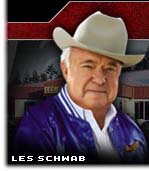 Born on a hardscrabble homestead near Bend, he grew up in a two-room shack at a nearby logging camp, where he attended grade school in a converted boxcar with "crooked windows cut in the side." When Les was orphaned at age 15, he rented a room at a boarding house for $15 a month and delivered newspapers while struggling to finish high school. Born on a hardscrabble homestead near Bend, he grew up in a two-room shack at a nearby logging camp, where he attended grade school in a converted boxcar with "crooked windows cut in the side." When Les was orphaned at age 15, he rented a room at a boarding house for $15 a month and delivered newspapers while struggling to finish high school.
After graduation, he married his high-school sweetheart and continued selling newspapers. He borrowed $11,000 from his brother-in-law in 1952, sold his house and borrowed on his life-insurance policy to purchase O.K. Rubber Welders, a small tire and retreading shop.
Even though he knew nothing about tires and had no formal business training, by the end of his first year in business, Schwab had increased sales fivefold to $150,000. By 1955, he had opened four more stores.
Today, the company has 410 retail tire stores across the Western U.S., employs 7,700 and generates $1.6 billion in sales, selling 6 million truck and car tires. Les Schwab Tires is privately held, adds 20 new stores a year and pays for them in cash.
How did this remarkable success come about? ... (more >>>) (posted 5/21/2007)
Why Sears Is Dying In The Retail Biz (Reason #493): Last week, a Sears sale flyer arrived in the mail. It was addressed to the previous occupant, who moved in 1989. (posted 9/18/2006)
Westfield Deathtown? I took a stroll around the Vancouver Mall recently. There were so many shuttered spaces, I could hardly believe my eyes. And many remaining stores had such cheap signage, you could tell they weren't planning to be there long term. (posted 8/30/2006)
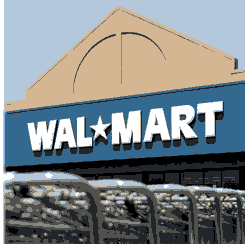 The Giant Store That Small People Love To Hate - Part II: Glenn Reynolds weighed in on Wal-Mart: "I've never understood why Wal-Mart makes some people crazy, but it clearly does. ... I think there's a class issue: Wal-Mart is unavoidable evidence that the American working classes don't think, or live, the way the American thinking classes want to imagine. For this sin, Wal-Mart can never be forgiven." The Giant Store That Small People Love To Hate - Part II: Glenn Reynolds weighed in on Wal-Mart: "I've never understood why Wal-Mart makes some people crazy, but it clearly does. ... I think there's a class issue: Wal-Mart is unavoidable evidence that the American working classes don't think, or live, the way the American thinking classes want to imagine. For this sin, Wal-Mart can never be forgiven."
Some 56% of U.S. consumers think Wal-Mart Stores Inc. is bad for America, according to a Zogby International poll released by one of the retailer's most vocal critics. The poll was commissioned by WakeUpWalMart.com, a union-funded group, so one has to question its objectivity. Mark Tapscott also takes issue with such 'polls'.
Kevin Hassett wrote: "One recent estimate suggests Wal-Mart directly and indirectly (by forcing rivals to keep their prices down) saved the average U.S. household $2,329 in 2004. These gains help low-income individuals the most. ... The retailer also is clearly a highly desirable place to work, offering its employees career advancement, health insurance and personal satisfaction. New York University economist Jason Furman notes that a recent store opening in Glendale, Arizona, received 8,000 applicants for 525 jobs. The number of applications suggests, Furman writes, that "a Harvard applicant has a higher chance of being accepted than a person applying for a job at that Wal-Mart.''
Most of the people who 'hate' Wal-Mart have never lived in a small town. I have. Such towns are full of merchants offering aging merchandise at remarkably high prices. Store owners whine about "people going out of town to buy stuff" and "not supporting the local guy." I used to hear such complaints when I stood in line with these fellow small business owners at the town's miniscule post office.
Little did these folks know that I was one of the traitors who traveled elsewhere to buy stuff.
On one occasion, our local men's store advertised a 40% off sale on Florsheim shoes. I arrived when the store opened the first day of the sale; there were exactly two pairs of shoes on sale. Some sale. (I guess the reason the extra pair was on sale was so that the store could use the plural form in the ad: "pairs of shoes.") Neither was my size. The owner of this business was active in the local business association and would loudly and frequently rant about the lack of buyer loyalty to "hometown businesses."
During my 12 years in this little Oregon burg, I never bought a pair of shoes locally. I spent my footwear dollars in Portland, Seattle, New Hampshire and New Jersey. I paid to send my purchases home via UPS and still saved money.
These local merchants paid their help poorly - often minimum wage - and offered few benefits. For many such employees, the opening of a Wal-Mart became a opportunity to move up. Wal-Mart prospered by opening stores in small towns where the 'competition' considered themselves entrenched and were, therefore, indifferent and lazy. Easy pickings.
Merchants who have been "driven out of business by Wal-Mart" went belly-up because they did nothing to differentiate themselves. Or failed to offer services unavailable from the mega-giant. Or wouldn't stock specialty products not offered by Wal-Mart. Or couldn't be bothered to give a better level of service.
Survival isn't always easy - but it's not impossible either, especially if you're clever, caring and customer-driven. (posted 12/22/2005, permalink)
The Giant Store That Small-Minded People Love To Hate: Andrea Harris at Spleenville weighs in on Wal-Mart. "You know, maybe people shop at Wal-Mart because it's convenient, cheap, and they can get something they need there. For instance, I needed a sweater today. I don't happen to own a car (I can't afford one right now), and I needed a new sweater. Alas, the free trade organic wool from Alpacas raised by real live Incan children sweater store is a bit far away for me to go at lunch time, so I went to Wal-Mart. Sue me, I found a sweater for fifteen bucks, and I didn't have to buy a hundred of them in a carton like at Costco."
Mark Tapscott has some interesting things to say about some of the more-vociferous Wal-Mart foes here.
In Sunday's paper, I read that newspapers are pressuring Wal-Mart to become an advertiser. (Big box discounters typically use low-prices rather than print ads to draw customers.) No wonder Wal-Mart gets bad press!
Frankly, I'm exhausted from listening to people whine about the MWWM - Most-Wicked Wal-Mart. No one's forcing people to shop there. I get my prescriptions and other stuff from Wal-Mart. Friendly employees; good prices. (posted 12/12/2005, permalink)
Monorail Memories: I saw a news item on television recently, announcing that the kiddie monorail which runs along the ceiling of the 'Santaland' toy department at Meier & Frank Department Store in downtown Portland will be closing after this Christmas season. The store is being renovated and the 50-plus year-old monorail doesn't meet current safety regs.
This brought back memories of riding the monorail for tots at Wanamaker's in Philadelphia in the early 1950s. The 'Rocket Express' monorail at Wanamaker's department store was in operation from 1946 to 1984.
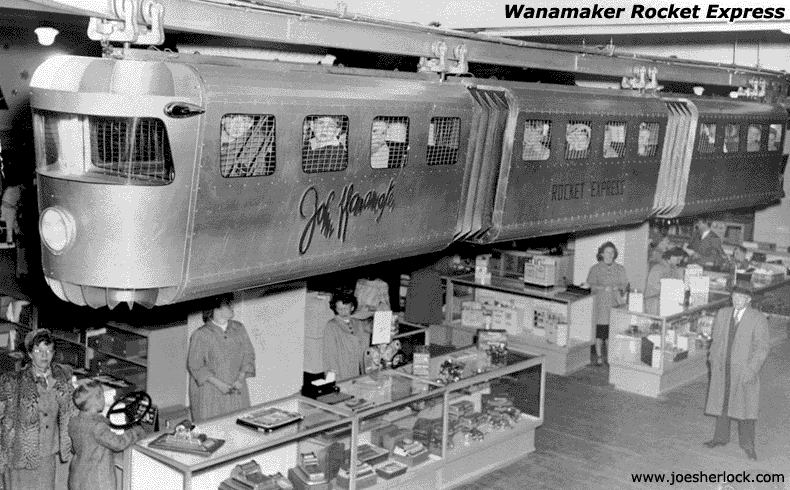
Kids would climb a staircase and hop aboard the red and silver-colored train to get a birds-eye view of whichever toys they were going to beg their parents to buy as the train circled Wanamaker's 8th floor Toy Department.
A Google search informed me that there were a plethora of kiddie monorails running on ceiling-mounted track systems at department stores across the U.S., including Rochester NY, Newark NJ and Atlanta GA.

All of these rides were produced by the Louden Machinery Company of Fairfield, Iowa. In 1919, Louden began producing a monorail overhead traveling crane system - primarily for material handling at manufacturing plants. Louden Machinery was formed in 1881 by William Louden and his wife. In 1895, Louden was granted a basic patent on the first flexible door hanger which was the forerunner of most present-day door tracks and hangers. He also invented the modern dairy barn and the manure spreader.
Enterprising 'Santaland' travelers (under 51 inches in height) can still ride the Louden Supertrack monorail for a ceiling's eye view of the Christmas festivities in Portland. Don't delay, though - time is short.
The original Wanamaker monorail cars are on display at the Please Touch Museum in Philadelphia. (posted 11/28/05, permalink)
Scenes From A Mall: Don't look for research and stats here; these are just observations. In the last few weeks, I visited the local mall a couple of times. It used to be called the Vancouver Mall but has been renamed Westfield Shoppingtown. I don't know anyone who calls it that; everyone says, "I'll meet you at the Vancouver Mall." Or "the mall." It's located on Van Mall Drive, by the way. 'Westfield Shoppingtown Drive' wouldn't fit on the street sign. Or would require a signboard so long that it might break the pole, fall and kill someone.
I was surprised by the increased number of security cameras inside the mall - a good thing, I suppose. (Especially if you're in the security camera biz.) The formerly wide lanes of the mall's interior are full of portable displays and kiosks tended by bored people. It felt like a bazaar in some third-world country - too crowded with merchandise. Sears looked especially dumpy - at its inside-the-mall entrance, Sears placed a tire display in center of the doorway. Guess they've given up on making high fashion statements. It just hasn't been the same since ol' Roebuck died.
Every nook and cranny in the mall was filled with devices to take your money - odd little kiddie rides, rows of gumball machines, etc. Two soda pop vending machines under an escalator well were tied together with a sign proclaiming that this was the 'Westfield Refreshment Center'. I'm surprised the gumball machines weren't labeled as the 'Westfield Elastomeric Mastication Center'.
Several cars were on display inside the mall, adding to the clutter. One was a bright, eye-bleeding yellow Nissan Sentra SE-R Spec V sedan. This model is well-known to be discounted $3,000 or so off list in this area, yet the local dealer - in a display of chutzpah not seen since Leona Helmsley proclaimed to her maid that "only the little people pay taxes" - added a special sticker with a $1,995 'Market Adjustment'. (That would be upward adjustment, not downward.) Then dealers wonder why no one believes anything they say, including "Good Morning."
I also spotted a Relay, a generic GM minivan sporting a butch, SUV-like proboscis with Saturn badges. I don't know which is funnier - sticking a manly front end on a minivan, or on a Saturn. Some of the cars on display suffered from benign neglect, covered with a coat of dust thicker than on my own car - and I've been driving all over and haven't washed it for three weeks.
In the 1980s, malls used to be bustling centers of retail commerce. The aisles and walkways were full of people. Now, they seem to be virtually empty - just some elderly people strolling for exercise and passing the time. Stopping occasionally to gawk but not buying anything. I don't know how the retail tenants manage to stay in business.
There were some shopper-mommies in attendance, blocking the aisles of stores with their humongous strollers. Andrea Harris from Spleenville describes these baby-transporting Goliaths: "I went to the mall today. Hordes of mothers were there, pushing strollers decked out like cruise ships with every single possible item baby could want - holders for sippy cups, dangly bars for mobile toys to dangle from, 5-cd changers, iPods ... Most of these behemoths, the SUVs of the infant-care set, contained one cranky, screechy, flopping and wriggling creature. There’s a message in there somewhere, but mostly I wondered just how much time and trouble it took to load all that equipment into the family vehicle, especially since all cars transporting children have to have the kid strapped in like an astronaut in the space shuttle ..." (posted 9/2/2005, permalink)
The Only Sound Is From Muzak: All of the 'music stores' around here are disappearing. People buy CDs over the internet. Or download them.
The gigantic Lloyd Center Mall in Portland (at one time it was the largest mall in the world) has neither book stores nor music stores in it anymore - B. Dalton and Waldenbooks abandoned their spaces. And the last men's shoe store (Florsheim) closed shop last year. Now it's full of specialty detritus stores - Spencer Gifts, Claire's and a lot of free-standing kiosks selling unneeded junk (flame-painted cell-phone covers, necklaces, tasteless embroidered pillows and throws, etc.).
The Vancouver Mall (which insists - in a 1990s Prince kind of way - that it's name is now Westfield Shoppingtown, although no one calls it that) is pretty much the same way.
You can still buy men's dress shoes in either mall - but you have to go to Nordstrom. (posted 5/9/2005)
Disclaimer
The facts presented in this blog are based on my best guesses and my substantially faulty geezer memory. The opinions expressed herein are strictly those of the author and are protected by the U.S. Constitution. Probably.
Spelling, punctuation and syntax errors are cheerfully repaired when I find them; grudgingly fixed when you do.
If I have slandered any brands of automobiles, either expressly or inadvertently, they're most likely crap cars and deserve it. Automobile manufacturers should be aware that they always have the option of trying to change my mind by providing me with vehicles to test drive.
If I have slandered any people or corporations in this blog, either expressly or inadvertently, they should buy me strong drinks (and an expensive meal) and try to prove to me that they're not the jerks I've portrayed them to be. If you're buying, I'm willing to listen.
Don't be shy - try a bribe. It might help.
|
|

